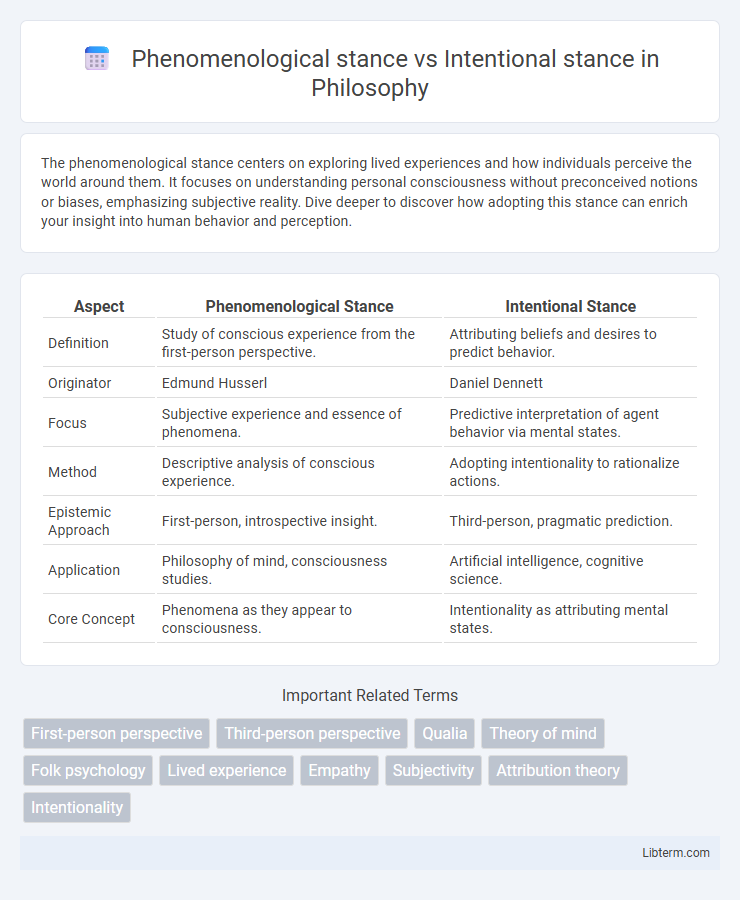The phenomenological stance centers on exploring lived experiences and how individuals perceive the world around them. It focuses on understanding personal consciousness without preconceived notions or biases, emphasizing subjective reality. Dive deeper to discover how adopting this stance can enrich your insight into human behavior and perception.
Table of Comparison
| Aspect | Phenomenological Stance | Intentional Stance |
|---|---|---|
| Definition | Study of conscious experience from the first-person perspective. | Attributing beliefs and desires to predict behavior. |
| Originator | Edmund Husserl | Daniel Dennett |
| Focus | Subjective experience and essence of phenomena. | Predictive interpretation of agent behavior via mental states. |
| Method | Descriptive analysis of conscious experience. | Adopting intentionality to rationalize actions. |
| Epistemic Approach | First-person, introspective insight. | Third-person, pragmatic prediction. |
| Application | Philosophy of mind, consciousness studies. | Artificial intelligence, cognitive science. |
| Core Concept | Phenomena as they appear to consciousness. | Intentionality as attributing mental states. |
Introduction to Phenomenological and Intentional Stances
The phenomenological stance emphasizes understanding experiences from the subjective perspective of conscious agents, focusing on how phenomena appear to individuals. The intentional stance, proposed by philosopher Daniel Dennett, involves interpreting entities by attributing beliefs, desires, and rationality to predict behavior. Both stances serve as foundational approaches in philosophy of mind and cognitive science to explain mental states and intentionality.
Defining the Phenomenological Stance
The phenomenological stance centers on understanding experiences from the first-person perspective, emphasizing subjective consciousness and how phenomena appear to the individual. It involves suspending assumptions about external reality to explore the essence of lived experiences and intentionality, the directedness of consciousness toward objects or states. This approach prioritizes the qualitative aspects of perception, emotions, and thoughts, aiming to grasp the meaning structures underlying human experience.
Understanding the Intentional Stance
The intentional stance, developed by philosopher Daniel Dennett, involves interpreting behavior by attributing beliefs, desires, and rationality to agents as if they have intentions guiding their actions. This stance simplifies prediction and explanation by treating entities as rational agents, enabling effective understanding of complex behaviors in humans and artificial systems. Unlike the phenomenological stance, which emphasizes subjective experience, the intentional stance prioritizes functional interpretation over internal consciousness.
Philosophical Foundations of Both Stances
The phenomenological stance emphasizes direct experience and consciousness as the foundation for understanding phenomena, rooted in Husserl's concept of intentionality where consciousness is always about something. The intentional stance, developed by Daniel Dennett, interprets behavior by attributing intentional states such as beliefs and desires, treating intelligent systems as rational agents to predict actions. Both stances share intentionality as a core philosophical foundation but diverge in approach: phenomenology prioritizes first-person subjective experience, while the intentional stance adopts a third-person interpretive framework focused on functional explanations.
Key Differences Between the Two Approaches
The phenomenological stance emphasizes first-person subjective experience, focusing on how phenomena appear to consciousness and the lived reality of individuals. The intentional stance, coined by philosopher Daniel Dennett, involves interpreting behavior by attributing beliefs, desires, and rationality to agents as if they possess intentions. Key differences include the phenomenological stance's commitment to describing experience from within versus the intentional stance's external, predictive framework based on inferred mental states.
Applications in Cognitive Science and AI
The phenomenological stance emphasizes understanding subjective experience and consciousness through first-person perspectives, crucial for developing AI systems that mimic human-like awareness and self-reflection. The intentional stance, focusing on attributing beliefs, desires, and intentions to predict behavior, underpins cognitive models used in AI for theory of mind and social interaction tasks. Integrating both stances enhances AI's ability to process not only observable behavior but also the underlying experiential context, improving human-machine interaction and adaptive learning.
Strengths and Limitations of the Phenomenological Stance
The phenomenological stance offers deep insights into subjective human experiences by emphasizing individual perception and consciousness, making it invaluable in fields such as psychology and philosophy. Its strength lies in capturing the richness of lived experience without reducing phenomena to mere physical or behavioral explanations. However, this approach is limited by its reliance on introspection, which can lead to challenges in objectivity and generalizability across different individuals or cultural contexts.
Strengths and Limitations of the Intentional Stance
The intentional stance excels in predicting and explaining behavior by attributing beliefs, desires, and rationality to agents, making it highly effective for understanding complex decision-making in humans and AI systems. Its strength lies in simplifying interactions through ascription of mental states, yet it is limited by the risk of anthropomorphism and may fail when agents act irrationally or unpredictably. This stance often overlooks underlying physical or neurological mechanisms, reducing explanatory depth in favor of functional interpretation.
Comparative Analysis: Practical Implications
The phenomenological stance emphasizes understanding experiences from a first-person perspective, prioritizing subjective consciousness, while the intentional stance interprets behavior by attributing beliefs and desires to predict actions. In practical applications, phenomenology informs therapeutic practices and design thinking by highlighting lived experience and meaning-making processes. Conversely, the intentional stance underpins artificial intelligence and cognitive science models by enabling behavior prediction through assumed mental states.
Conclusion: Integrating Perspectives for Deeper Insight
Integrating the phenomenological stance, which emphasizes first-person subjective experience, with the intentional stance, focused on attributing beliefs and desires to predict behavior, offers a richer understanding of human cognition. This combined approach bridges the gap between internal experience and external interpretation, enhancing models in psychology and artificial intelligence. Embracing both perspectives fosters comprehensive insights into consciousness, agency, and meaning-making processes.
Phenomenological stance Infographic

 libterm.com
libterm.com